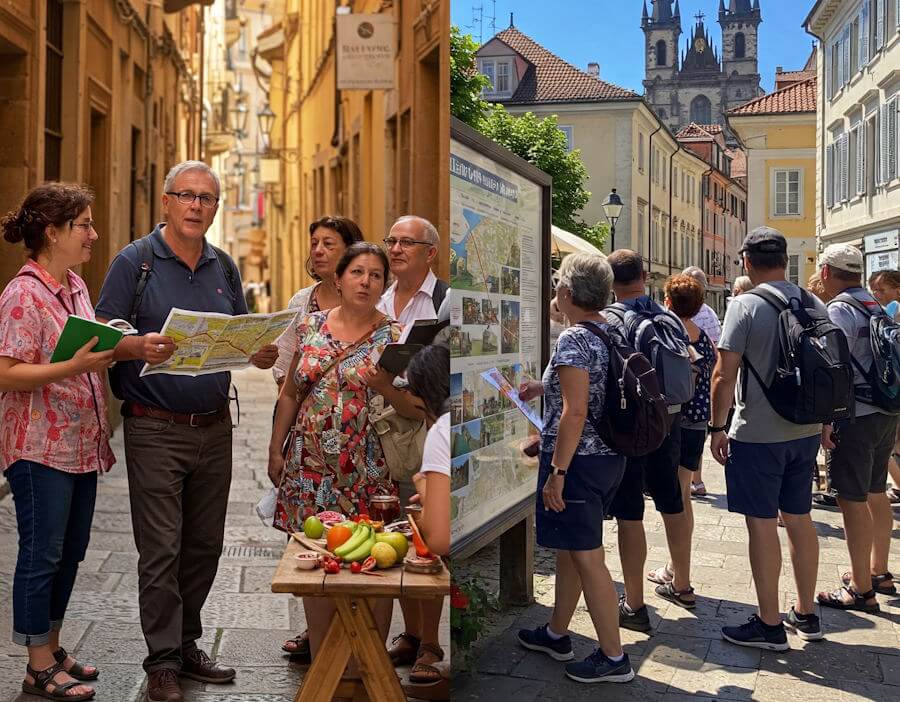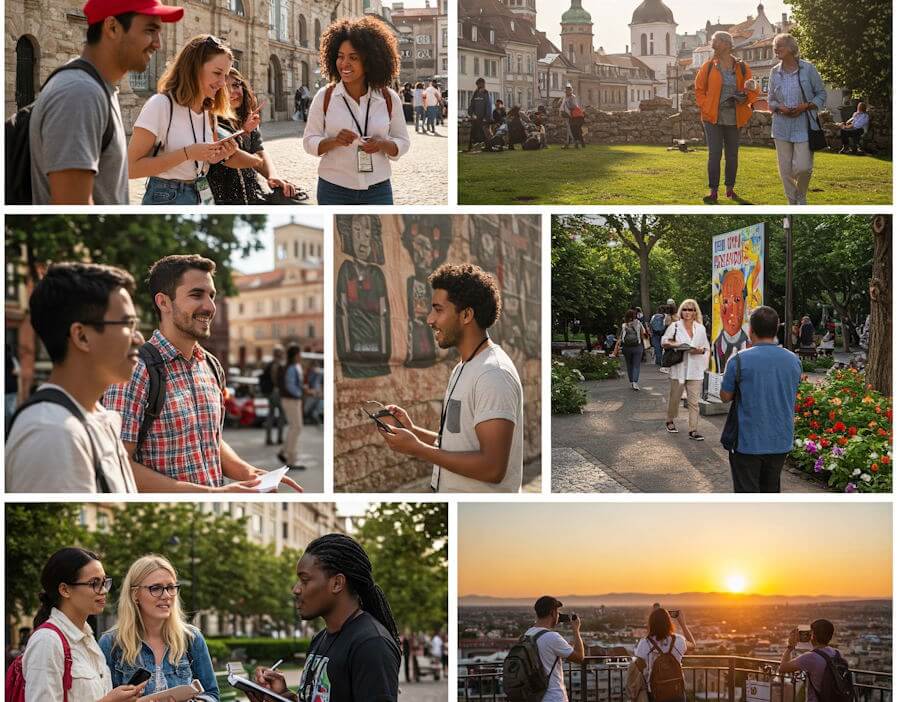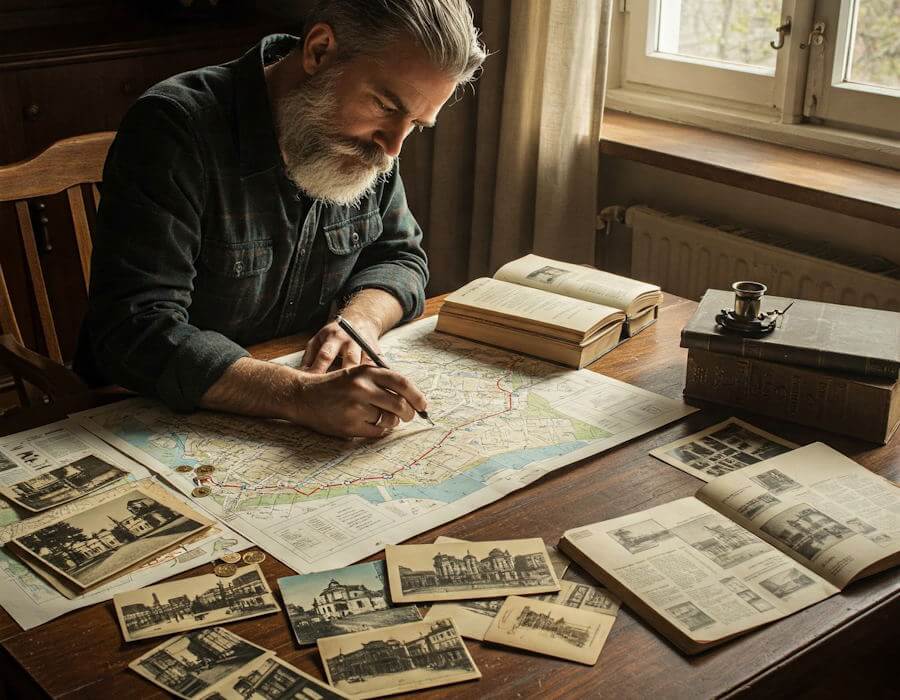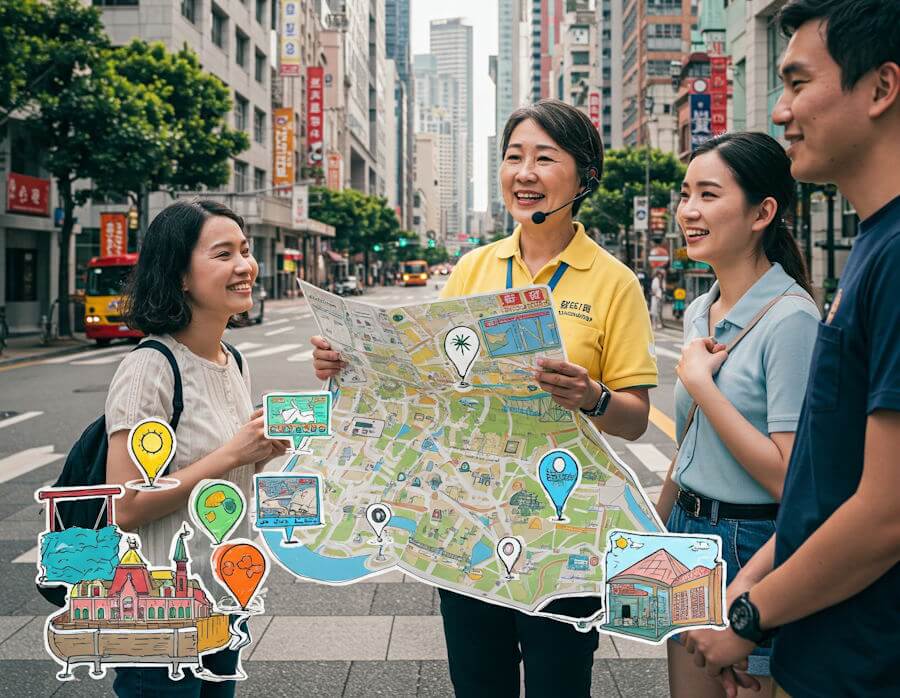The Significance of Tailored City Tours
City tours are a vital aspect of urban exploration, offering an avenue for individuals to engage with the rich tapestry of history, culture, and lifestyle unique to each location. However, the approach to creating these tours requires a fundamental understanding of the differing motivations and interests of two primary groups: locals and tourists. Tailoring city tours specifically for these demographics ensures that the experience is not only informative but also genuinely engaging.
Tourists often seek to immerse themselves in the essence of a city they may visit only once. Their interests typically revolve around iconic landmarks, historical sites, and cultural experiences that encapsulate the destination’s character. For this group, city tours serve as a gateway to understanding the aesthetic and historical narratives that define a place. Tourists may also inquire about local cuisine, shopping hotspots, and entertainment options, indicating a desire to experience the local flavor during their brief stay.
Conversely, locals possess a distinct knowledge base that alters their expectations from a city tour. Their familiarity with the area does not diminish their interest but shifts the focus to exploring hidden gems, local stories, and nuanced aspects of the city’s lifestyle. A tailored city tour for residents aims to unveil lesser-known sites, delve into the historical undercurrents of familiar places, and foster a sense of community connection. This nuanced approach allows locals to appreciate their surroundings in a new light, enhancing their engagement with the city they know well.
Recognizing the differences between locals and tourists thus serves as the cornerstone for creating meaningful city tours. By aligning the tour objectives with the specific interests and knowledge levels of each group, tour creators can significantly enhance the overall experience and satisfaction of participants, paving the way for deeper connections with the urban environment.
Understanding the Tourist Experience: What Tourists Look For
When embarking on city tours, tourists typically have distinct expectations that shape their overall experience. One primary desire is the opportunity to visit iconic landmarks, which represent the cultural and historical significance of a destination. These sites, whether they are famous buildings, monuments, or natural wonders, attract tourists because they encapsulate the essence of the city. For many, standing before such landmarks is not just a photographic moment; it represents a culmination of their interests and dreams associated with the location.
Moreover, tourists often seek cultural introductions that provide context to their visit. They are eager to learn about local customs, traditions, and practices that might differ significantly from their own. City tours that offer insights into the local culture, whether through guided narratives or interactive experiences, enrich the tourists’ understanding and appreciation of the community they are exploring. This facilitates a deeper connections between tourists and the locales they visit, enhancing their emotional journey.
Historical context is another critical element that tourists look for in city tours. Many travelers are drawn to the stories of the past—how cities evolved, their pivotal moments, and the figures that shaped them. This adds layers to their experience, transforming a simple visit into an educational adventure. Familiarizing oneself with local history enables tourists to perceive the city beyond its physical attributes; it becomes a mélange of narratives and perspectives that deepen their bond with the place.
Convenience also plays a vital role in the tourist experience. Tourists often prefer structured itineraries that minimize the hassles of navigation and decision-making. Organized city tours cater to this need by providing well-planned routes, expert guidance, and seamless transitions between attractions. Ultimately, the goal is to offer tourists a harmonious blend of discovery and relaxation, all while ensuring that their expectations are not only met but exceeded.
The Local Perspective: Interests and Insights of Residents
When considering city tours specifically for locals, it is crucial to understand their unique interests and preferences, which often diverge from those of tourists. Residents typically seek experiences that highlight the less commercialized aspects of their city, exploring hidden gems that might not be found in traditional tourist guides. These destinations often encapsulate the rich history and diverse culture of the area, providing locals with a renewed sense of appreciation for their surroundings.
In-depth cultural experiences are a priority for many residents. Rather than a superficial overview, locals prefer tours that delve into the stories and traditions that shape their city. Such tours may focus on historical events, local artisans, or unique culinary experiences that reflect the area’s identity. This approach not only educates participants but can also enhance local pride and foster a deeper connection to the community, encouraging individuals to engage with their city’s legacy actively.
Unlike typical tourist paths crowded with visitors, city tours designed for locals can methodically navigate through less trafficked locales, offering opportunities to enjoy the city’s charm away from the hustle and bustle. These routes often incorporate visits to local businesses, art galleries, and open markets, enriching the experience while simultaneously supporting economic sustainability within the community.
Moreover, social interaction plays a significant role in these experiences. Many locals appreciate tours that provide chances for dialogue and connection with fellow residents, facilitating the sharing of personal stories and insights about the city. This bonding over shared experiences strengthens community ties and creates an inclusive atmosphere that resonates with all participants. By focusing on these elements, local city tours can truly reflect the vibrancy and authenticity of urban life, catering specifically to the nuanced preferences of the residents.
Key Differences in Tour Content: Attractions and Themes
When designing city tours, it is imperative to recognize the distinct preferences between locals and tourists regarding attractions and themes. Local tours tend to emphasize a deeper understanding of the community, often focusing on hidden gems and lesser-known neighborhoods that are rich in history and cultural significance. For instance, a local tour may explore artisan communities, showcasing the work of local craftsmen or highlighting small businesses that contribute to the neighborhood’s unique character. This approach allows residents to appreciate the intricate narratives that are often overlooked in favor of more popular attractions.
In contrast, tourist tours typically prioritize must-see landmarks and historical sites that are iconic to the destination. Visitors generally seek to check off the well-known points of interest, such as major monuments, museums, and scenic vistas that define the city’s identity. These tours often incorporate a broader narrative aimed at educating tourists about the city’s heritage and significance, which aligns with their temporary experience and desire for a snapshot of the location.
Additionally, the themes of the tours can significantly differ. Local tours might have a thematic focus on sustainability, cultural practices, and community events that illustrate the vibrant life of the neighborhood, providing an authentic experience for the participant. On the other hand, tourist tours often follow thematics that are more conventional, such as historical overviews and architectural highlights, appealing to the general interests of travelers who may not have an intimate connection to the area.
Recognizing these key differences in tour content is essential for creating engaging and relevant experiences tailored to each audience. By aligning the attractions and themes with the specific interests of locals and tourists, tour organizers can effectively enhance participant satisfaction, enrich the overall experience, and promote a deeper understanding of the city’s multifaceted nature.
Tour Guide Approach: Tailoring Communication and Engagement
When it comes to creating city tours, the role of the tour guide is pivotal. Tour guides must adapt their communication and engagement strategies depending on whether they are catering to locals or tourists. For local audiences, guides can leverage a conversational tone that fosters dialogue and connects on a personal level. Locals tend to appreciate anecdotes and detailed stories that evoke shared experiences, cultural nuances, and historical context. This approach encourages interaction, allowing for a more immersive experience that makes locals feel valued and involved.
Conversely, when guiding tourists, the focus generally shifts to a more structured narrative. Tourists often seek highlights and curated information that align with their expectations of a guided city tour. The tone may be more formal and informative, as guides emphasize iconic landmarks and notable histories. In these cases, the storytelling becomes a performance—rich in engaging detail yet streamlined to cover a broader scope within a limited timeframe. Tourists may not have the same point of reference as locals, so guides must ensure clarity and accessibility, weaving in captivating stories that maintain interest without overwhelming their audience.
The level of detail is also a critical aspect of this tailored approach. For local tours, guides can delve into minutiae that enrich conversations, while tourist tours benefit from concise overviews that highlight essential facts. Ultimately, understanding the unique needs and expectations of both demographics allows tour guides to create enriching experiences that resonate with each group in a meaningful way. By adjusting their tone, storytelling style, and depth of information, tour guides play an essential role in transforming city tours into memorable adventures tailored for locals and tourists alike.
Marketing Strategies: Reaching Locals vs. Tourists
Creating effective marketing strategies is pivotal when designing city tours aimed at either locals or tourists. Each group has distinctive preferences and behaviors, which necessitates tailored approaches to reach and engage them effectively. Social media channels play a significant role in this strategy. For tourists, global platforms such as Instagram and Facebook are particularly effective, utilizing vibrant visuals and enticing narratives to showcase the city’s attractions. Influencer collaborations can also enhance visibility among travelers seeking authentic experiences.
In contrast, local audiences tend to gravitate towards more community-specific platforms or neighborhood-focused social media groups. Utilizing platforms such as Nextdoor or local Facebook groups allows businesses to engage with locals through meaningful interactions and familiar community ties. Content aimed at residents typically emphasizes the unique aspects of the tours that resonate with their daily lives, such as cultural events, historical insights, and hidden gems that may not be on a tourist’s radar.
Furthermore, forming partnerships with local businesses, community groups, and cultural institutions can be particularly advantageous. For tourists, collaborations with hotels, travel agencies, and tourist information centers can broaden outreach and provide promotional packages that include discounts or unique experiences. Conversely, local strategies should focus on building relationships within the community, perhaps through local festivals, farmer’s markets, or events that promote city tours while fostering local pride and participation.
Promotional offers also play a critical role in engaging these different demographics. Special discounts for locals or loyalty programs can entice residents, while limited-time offers or all-inclusive packages can attract tourists who are keen on maximizing their travel budgets. Understanding the specific motivations and needs of each audience significantly enhances the effectiveness of the marketing strategies employed, ensuring a successful campaign and a thriving tour business.
Challenges and Opportunities: Catering to Both Audiences
Creating city tours that appeal to both locals and tourists presents a unique set of challenges and opportunities. One primary challenge is achieving a delicate balance between novelty and authenticity. Tourists often seek new experiences and attractions that highlight the uniqueness of a location, while locals desire tours that reflect their cultural heritage and everyday life. Striking this balance requires a keen understanding of both audiences’ needs, which can prove difficult for tour developers.
Another challenge is pricing. Tourists may be willing to spend more on experiences tailored for them, while locals often prefer affordable options. As a result, tour operators are called to innovate pricing models that equally appeal to both demographics without alienating either group. Furthermore, the desire for inclusivity can complicate logistics; for instance, accommodating diverse languages and cultural sensitivities can stretch resources thinner.
However, these challenges present numerous opportunities for hybrid tours that celebrate the interplay between local life and tourist attractions. By incorporating local guides in the experience, operators can provide tourists with deep insights about the customs, traditions, and hidden gems that locals cherish. This approach not only enriches tourists’ experiences but also fosters a sense of pride among locals by showcasing their culture to a wider audience.
Furthermore, incorporating feedback from both locals and tourists can lead to the continuous improvement of tour designs. Engaging with community members can provide valuable insights into their interests, allowing operators to create unique experiences that resonate with various audiences. Ultimately, while the challenges of catering to both groups are considerable, they are often outweighed by the enriching opportunities that arise, enabling a more dynamic and vibrant touristic experience.
Case Studies: Successful City Tours for Both Locals and Tourists
City tours have the potential to resonate deeply with both locals and tourists when crafted with distinct features that cater to the unique interests of each group. A compelling example of this integration can be found in the “Hidden Gems of downtown” tour held in a bustling metropolitan city. This tour combines historical insights with local anecdotes, appealing to residents who may be unfamiliar with their own city’s hidden treasures as well as to tourists seeking authentic experiences. Feedback collected through post-tour surveys demonstrated a 95% satisfaction rate among participants, highlighting the effectiveness of the tour’s blend of storytelling and exploration.
Another successful model is the “Culinary Journey: A Taste of Tradition” tour, which focuses on the city’s diverse culinary landscape. Designed with input from local chefs and residents, this tour not only showcases exquisite dining options but also includes hands-on cooking classes. This interactive element engaged both locals wishing to learn new techniques and tourists eager to delve into the local cuisine. Participants praised the community involvement, emphasizing a stronger connection to the culture, with many locals returning to share their newfound cooking skills with friends and family.
A third example is the “Cultural Festivals Tour,” which aligns with various seasonal events and celebrations. This tour effectively capitalized on local festivals that draw both residents and visitors, presenting an opportunity for individuals to mingle, discover local traditions, and enjoy entertainment. Tour guides emphasized the significance of each festival, bridging cultural gaps and fostering community spirit. Post-tour evaluations indicated high levels of participant engagement, with many attendees expressing a desire to return for future festivals. The blend of cultural insights and festive atmosphere delivered an enriching experience for all.
These case studies illustrate that successful city tours are not merely about presenting landmarks; they are about weaving narratives that connect the past with the present, offering both locals and tourists a multifaceted understanding of the city. Such strategic design elements can serve as benchmarks for creating impactful city tours that resonate with varied audiences.
Conclusion: Best Practices for Creating Inclusive City Tours
In the realm of urban exploration, the creation of city tours that effectively cater to both locals and tourists is essential for fostering inclusivity and enriching the overall experience. One of the most vital best practices involves conducting thorough research to understand the distinct preferences and needs of both groups. By recognizing that locals often seek deeper insights into their surroundings, while tourists look for iconic landmarks, tour creators can craft experiences that resonate with both demographics.
Another critical aspect is to incorporate storytelling into the tours. Compelling narratives can bridge the gap between tourists and locals, offering unique perspectives that illuminate cultural nuances and shared histories. Integrating local voices, such as community leaders or area residents, can enhance authenticity and enrich the experience for participants, encouraging a sense of connection to the city regardless of their background.
Additionally, accessibility should be at the forefront of tour design. This includes catering to individuals with diverse physical abilities and ensuring that information is available in multiple languages. Such considerations promote an inclusive atmosphere, allowing everyone to enjoy the sights and learn from the tour experience.
Furthermore, leveraging technology can create a more engaging experience. Utilizing apps or virtual reality can provide interactive elements that appeal to tech-savvy tourists while still appealing to the local audience through unique content and features. By blending modern tools with traditional storytelling, cities can enhance the overall tour experience for all attendees.
In conclusion, embracing a comprehensive approach that values inclusivity, authentic narratives, and modern technology will empower tour creators to develop city tours that are enriching and memorable for both locals and tourists. This will not only elevate the overall tourist experience but also strengthen community ties, fostering a deeper appreciation for the urban environment.




